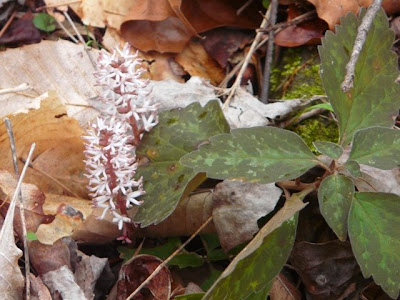Tony Troche, Lindsay, and I were in Missouri last week to spend some time in the herbarium at the Missouri Botanical Garden with Dana and Justin Thomas (and their son Eli). On Friday afternoon, we left the Garden and drove southwest to Salem, Missouri, where we stayed with Justin and Dana for the weekend. On Sunday, Tony, Justin, and I took a botanizing trip to Carman Springs Natural Area. Our target was
Claytonia ozarkensis, a plant collected only twice in Missouri, and that has since become extirpated from the state. We knew that it was probably a bit early to find it in flower, but we hoped that since we had seen a few
Claytonia virginica in bloom further north, maybe at least the leaves of
C. ozarkensis would be visible if the plant was indeed present at Carman Springs. We searched along a creek on the exposed sandstone layers that were sandwiched between dolomite, using binoculars when the terrain was not hikable. While we did see some very interesting plants, including the remains of
Carex woodii and Parnassia grandiflora and fresh leaves of
Selaginella eclipes and
Dodecatheon meadia, we did not locate any
C. ozarkensis. Maybe next time.
At one point on our hike along the creek, Justin noticed some yellow-green leaves high on a steep face of a bluff. We couldn't resist climbing up this shallow-soil incline to find out to what species these leaves belonged (we eventually found that they were Dodecatheon meadia leaves). On the way up, we came across Hepatica americana (=H. nobilis var. obtusa) in bloom, and we couldn't resist taking photos.


Unfortunately, these photos don't do justice to the incline we were dealing with. This photo of Tony on the slope in an adjacent glade community helps to show the incline, but the area on which the H. americana was growing was even more steep.

In a glade portion of the bluff, we found Verbena canadensis (=Glandularia canadensis) in bloom.

This is just a taste of some of the earliest blooming Ozarkian flora to wet your whistle on this first day of spring.
 Pennywort
Pennywort Pennywort
Pennywort
 Allegheny Spurge
Allegheny Spurge











 The genus gets its name from the aggregated ovaries (symploce is Greek for connection, and carpos refers to the fruit), while the specific epithet foetidus refers to the foul odor of the plant when bruised. If you were a fly, you would love the skunky odor emitted by good ol' skunk cabbage, and it would draw you to the plant, where you would unknownly collect and spread its pollen.
The genus gets its name from the aggregated ovaries (symploce is Greek for connection, and carpos refers to the fruit), while the specific epithet foetidus refers to the foul odor of the plant when bruised. If you were a fly, you would love the skunky odor emitted by good ol' skunk cabbage, and it would draw you to the plant, where you would unknownly collect and spread its pollen.
